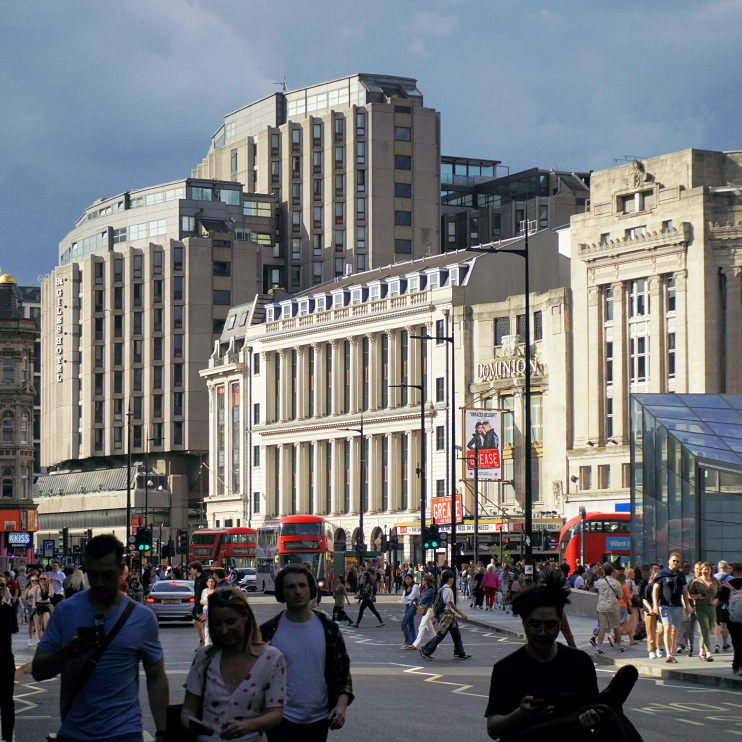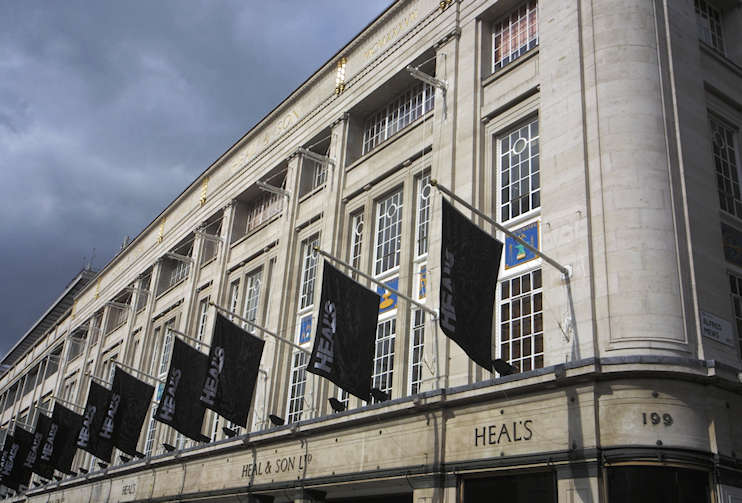Tottenham Court Road
Tottenham Court Road, Camden
A commercial thoroughfare running along the western edge of Bloomsbury, noted for its furniture and electronics retailers

The Elizabethan manor house of Tottenhall stood on the site now occupied by the UCLH administrative building at 250 Euston Road – the one that’s faced with so much reflective glass it almost disappears into the surrounding sky. Excavations here have uncovered early Saxon pottery, a series of 13th- to 14th-century yard surfaces and the remains of medieval and Tudor walls.
By the time of the manor house’s demolition in the early 18th century, its name had become corrupted to Tottenham Court and the lane that ran here from St Giles was called Tottenham Court Road. The mutation from ‘Tottenhall’ to ‘Tottenham’ was prompted by public familiarity with the north London district of that name, although the manor had no connection with that place.
From the late 18th century and especially in the 19th century, Tottenham Court Road was known for the manufacture of furniture, especially cabinets. Some of the workshops later turned to piano-making.
Built in 1896 in Art Nouveau Gothic style, the surviving architectural highlight of the west side is the Rising Sun public house, at number 46. Tottenham Court Road’s Central line station opened in 1900 and the Northern line stations along its length all opened in 1907.
Furniture retailing grew in tandem with the manufacturing industry and several grand emporia were erected on the street in the 1910s and 1920s. The finest of these was (and still is) Heal’s, which had already been on Tottenham Court Road for almost a century before its store was enlarged and endowed with a Portland stone façade in 1912–17 (and later extended southwards). Pevsner calls it “the best commercial front of its date in London.”

Visible in the photo at the top of this article, the Dominion Theatre was built at the southern end of Tottenham Court Road in the late 1920s, backing onto the site of Meux’s brewery – once the source of the London Beer Flood. The Dominion served as a cinema for most of its first 40 years and nowadays devotes itself almost exclusively to musical theatre.
Beneath Tottenham Court Road’s junction with Chenies Street lies the bunker from which General Eisenhower directed the Allied forces’ liberation of Western Europe. It is now used for the secure storage of documents and data.
With its preponderance of bank branches and sandwich purveyors, Tottenham Court Road’s mix of businesses increasingly resembles that of any other central London high street, but north of Goodge Street there’s still a bias towards furniture retailing, while further south there are specialists in audiovisual, photographic and computer equipment.
Other distinctive presences include Paperchase (at numbers 213–215), Spearmint Rhino (161), the American church (79a), the Scientologists (68) and the Odeon (30).
Making a diagonal link with Oxford Street at the southern end of Tottenham Court Road is hidden-away Hanway Street, a conservation area with some recherché shops and bars, including a couple with Spanish connections – a reminder that Tottenham Court Road once had a reputation as London’s Latin quarter.
The arrival of the Elizabeth line at Tottenham Court Road, which eventually happened in May 2022, is expected to result in a 40 per cent increase in passenger traffic through the hugely enlarged station, making it busier than Heathrow airport. Accordingly, Camden council has carried out a phased programme of improvements to the neighbouring public realm – and from spring 2021 sections of Tottenham Court Road were restricted to buses and bicycles during the daytime from Monday to Saturday.
In George Bernard Shaw’s play Pygmalion, Eliza Doolittle sells flowers on the corner of Tottenham Court Road. In Lerner and Loewe’s musical adaptation, My Fair Lady, Eliza lives in a Tottenham Court Road tenement, although she goes home to Drury Lane in the original play.
Tottenham Court Road station was scene of David’s attack on a lone commuter in John Landis’s spoof horror film An American Werewolf in London.
Postal district: W1 (the boundary with WC1 runs along the road’s eastern side)
Station: Elizabeth, Central and Northern lines (zone 1)
See also: Warren Street
